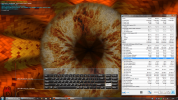Hi
Running hwinfo64 on inspiron 5576 laptop. CPU is FX-9830P with integrated R7 graphics and there is also GPU RX560 chip.
Having several problems here, unsure whether all are driver related or some possibly hwinfo bugs.
1. there is no voltage sensor on integrated graphics. running linux with kernel 5.6 exposes this sensor and readings are correct, but nothing on win7/win10
2. as soon as the AUX power exceed 10W on dedicated GPU the sensor disappear from hwinfo (see screenshot)
3. GPU core current is capped at 69.727A, i think it is system BIOS or driver limit, but not sure since raising voltage increases power draw from wall (for this reason i think it is not VRM limit, at least not VR but could be MOSFET limit) (see screenshot)
Any ideas?
Running hwinfo64 on inspiron 5576 laptop. CPU is FX-9830P with integrated R7 graphics and there is also GPU RX560 chip.
Having several problems here, unsure whether all are driver related or some possibly hwinfo bugs.
1. there is no voltage sensor on integrated graphics. running linux with kernel 5.6 exposes this sensor and readings are correct, but nothing on win7/win10
2. as soon as the AUX power exceed 10W on dedicated GPU the sensor disappear from hwinfo (see screenshot)
3. GPU core current is capped at 69.727A, i think it is system BIOS or driver limit, but not sure since raising voltage increases power draw from wall (for this reason i think it is not VRM limit, at least not VR but could be MOSFET limit) (see screenshot)
Any ideas?
Attachments
Last edited:

